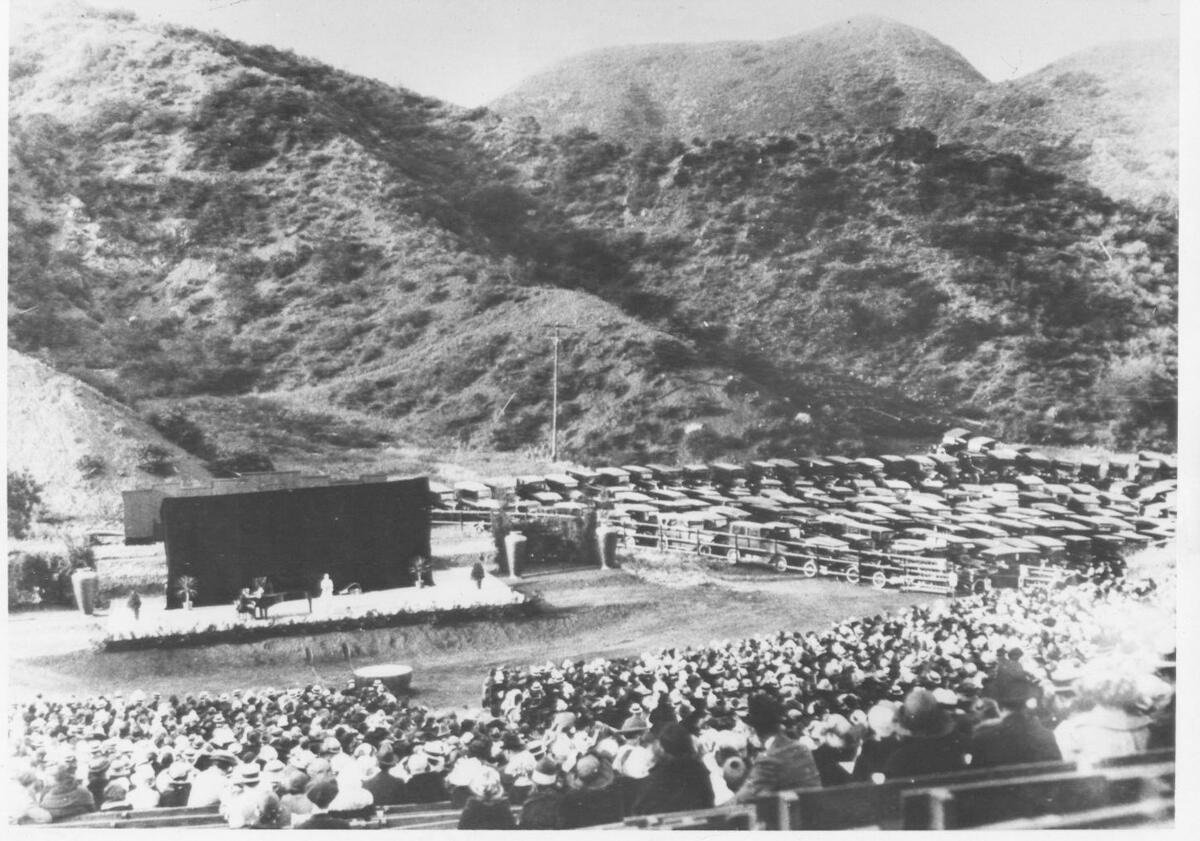Review: Gustavo Dudamel puts a remarkable ‘Rite of Spring’ in a revealing Latin American context

One of the most important dates in classical music is the April 2, 1913, premiere of Stravinsky’s “The Rite of Spring,” but not for the famous riot that disrupted the ballet in Paris’ Théatre des Champs-Élysées. Thanks to “The Rite,” rhythm and meter took on new consequence in European music that went on to revolutionize music of all sorts just about everywhere, Latin America very much included.
That is the point of Gustavo Dudamel’s two-week Stravinsky ballet cycle, in which he is pairing the composer’s great Ballets Russes scores — “Firebird” and “Petrushka” along with “The Rite” — with a classic Latin American ballet or film scores. The cycle also includes new pieces from Latin American composers written for the occasion.
“The Rite” — and it was a “Rite” to be remembered Thursday night — came first. It always does with the Los Angeles Philharmonic and at Walt Disney Concert Hall. L.A. may have been a little slow on its “Rite” uptake, but in the nine decades since the L.A. Phil’s 1928 West Coast premiere of the score at the Hollywood Bowl, the “Rite” has ruled in this town, where Stravinsky spent most of the second half of his life.
Our “Rite” list is long, so let’s leave it at a few highlights. Stravinsky conducted it often here. Disney’s “Fantasia” wouldn’t have been the same without “The Rite,” and animation wouldn’t have been the same without “Fantasia.” Local composers and musicians of all stripes, in and out of Hollywood, were in Stravinsky’s thrall.
The L.A. Phil, meanwhile, became “Rite” Central. Zubin Mehta performed it in the opening week of concerts for the Dorothy Chandler Pavilion in 1964. Esa-Pekka Salonen opened Disney in 2003 with it and made it a sort of signature tune for the hall.
For his part, Dudamel needed no encouragement to take up the L.A. “Rite” mantle. As a young child he pretend-conducted toy soldiers to a Salonen “Rite” recording. In 2010, the year after becoming music director of the L.A. Phil and a few days after turning 29, Dudamel made such an excited live “Rite” recording with his massive youth Simón Bolívar Symphony Orchestra of Venezuela that it might serve as an aural adrenaline supplement.
Still, for all his youthful exuberance, Dudamel had a lot to live up to. His first L.A. Phil “Rite” of passage, two years later, offered an excess of youthful vivacity, speed and hyper expressivity. Stravinsky, who disliked exaggeration, believed his music should speak for itself. Dudamel appeared to want it to speak for everybody. Too much adrenaline, however, blurs the senses.
After another decade, Dudamel’s “Rite” has become less showy. The thrills are now new and more lasting. Impressive power and authority no longer need knock your socks off. Best to keep them on. This is momentous business.
The weight of Dudamel’s “Rite” is what gets you first. From the start, Whitney Crockett’s opening bassoon solo had emotional presence that sounded fuller and richer than that of any single voice. Rather, it was part of something larger, an expression of significant occasion.
While never less than the life force it must be in “The Rite,” rhythm is less noticeable, acting more like a heartbeat. Attention is, instead, drawn to mood, atmosphere and, most meaningful of all, motivation. The rituals that drive this pagan sacrifice — the abduction of a young victim, the fearsome sages, the wild and will-suppressing ecstasy of the final “Sacrificial Dance” — become overpowering.
This “Rite” is no longer a fun ride but rather a warning. Dudamel graphically unleashes uncontrollable disastrous forces in us and then demonstrates the musical mastery needed to control those superhuman and dehumanizing forces. We can argue about so-called iconic L.A. experiences. But let there be no argument that a great “Rite” played by the L.A. Phil in Disney matters.
Dudamel also recorded Alberto Ginastera’s suite of four dances from his 1941 ballet, “Estancia,” with his Bolívars in 2007. Exuberant “Rite” rhythms can’t be missed, which the Argentine composer transposed to those of his native Argentine dance. On Thursday, Dudamel presented the full ballet score that follows the day in the life of a gaucho out to prove himself and win his love.
The young Ginastera (who was 26 when he wrote the ballet) may offer little in the much longer full score (which lasts 33 minutes, same as “The Rite”) of the excitement in the suite’s dances. But it puts them in rich context and gives substance to the final “Malambo,” which became a high-spirited encore for the Bolívars.
As in his Stravinsky, Dudamel found an expansiveness that went beyond dance rhythms, exciting though they were, and proved especially effective in the moonlit nocturnal parts not in the suite. Baritone Gustavo Castillo (who hails from Dudamel’s hometown, Barquisimeto, and is a member of La Scala in Milan) brought a dignified passion to his reading of parts of José Hernández’s poem “Martín Fierro,” which inspired “Estancia,” and his singing of its short vocal solos.
The new piece, Alex Nante’s ”El Río de Luz” (The River of Light), which opened the program, is a modest six-minute sweep of cloudy orchestral color that ends with a swift bang. Rhythm and meter for this young Argentine composer can, with pleasure, wait.
'The Rite of Spring'
What: Gustavo Dudamel conducts “The Rite of Spring”
When: 8 p.m. Saturday, 2 p.m. Sunday
Tickets: $71-$276
Info: (323) 850-2000, laphil.com
More to Read
The biggest entertainment stories
Get our big stories about Hollywood, film, television, music, arts, culture and more right in your inbox as soon as they publish.
You may occasionally receive promotional content from the Los Angeles Times.












